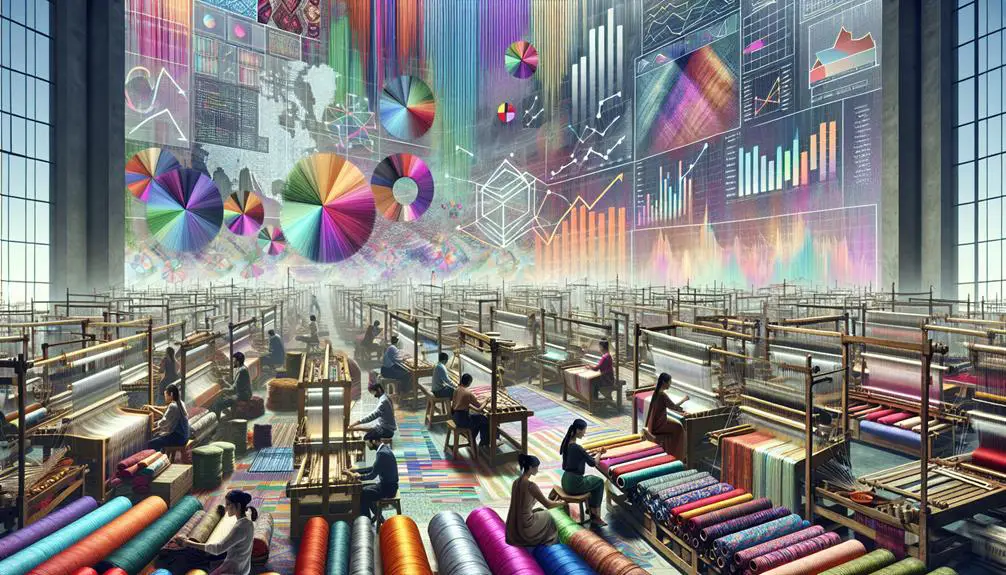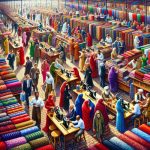As you consider the economics of fabrics, you'll notice a significant shift towards sustainability and ethical production. Consumers are increasingly demanding eco-friendly materials, pushing companies to adopt circular economy models and transparency in their supply chains. Yet, it's not just about going green; technological advancements like digital weaving and smart fabrics are reshaping production capabilities. Balancing these innovations with cost factors, such as labor wages and energy consumption, presents a complex landscape. How do these elements interplay with global trade dynamics and market demand shifts? Let's explore how these trends are shaping the fabric industry.
Table of Contents
Key Takeaways
- Increasing demand for eco-friendly and ethically produced fabrics influences market dynamics.
- Advancements in digital weaving technology enhance production efficiency and creative capabilities.
- Adoption of sustainable practices, like closed-loop systems and renewable energy, reduces long-term costs.
- Fluctuations in global trade policies and tariffs impact fabric prices and supply chain strategies.
- Consumer preference shifts towards natural textures and transparency drive brand loyalty and purchasing decisions.
Technological Innovations
Technological innovations are revolutionizing the fabric industry by enhancing production efficiency and fabric quality. One of the most transformative advancements is digital weaving. With this technology, you can achieve intricate patterns and designs with remarkable precision, reducing waste and errors.
Digital weaving not only speeds up the production process but also opens up new creative possibilities, allowing designers to push the boundaries of traditional fabric aesthetics.
Smart fabrics are another groundbreaking development. Imagine textiles that can change color, monitor your health, or even power your devices. These fabrics integrate electronic components directly into the fibers, creating a seamless blend of technology and textile.
For the discerning individual, smart fabrics represent the future of multifunctional clothing and home textiles.
Equally important are biodegradable textiles and eco-friendly fibers. As you aim for mastery in the fabric industry, understanding the shift towards sustainability is essential.
Biodegradable textiles break down naturally, reducing environmental impact. Meanwhile, eco-friendly fibers like organic cotton and bamboo offer sustainable alternatives without compromising quality.
Sustainable Practices
In your pursuit for a greener industry, embracing sustainable practices is crucial to reducing the environmental footprint of fabric production. Embracing a circular economy model guarantees materials are reused and recycled, minimizing waste and resource consumption.
You can start by sourcing eco-friendly materials like organic cotton, hemp, and recycled polyester, which have a lower impact on the environment compared to conventional fabrics.
To make your sustainable transformation effective, consider these key practices:
- Implement closed-loop systems: Design products for end-of-life recyclability, guaranteeing materials can be reused without loss of quality.
- Opt for renewable energy: Power your production facilities with solar, wind, or other renewable sources to decrease carbon emissions.
- Reduce water usage: Utilize innovative dyeing techniques and waterless technologies to preserve this precious resource.
- Promote transparency: Maintain an open supply chain where every step of the production process is traceable and ethical.
Consumer Preferences
As you adopt sustainable practices, you'll find that consumer preferences increasingly favor eco-friendly and ethically produced fabrics. Shoppers today are more discerning; they prioritize sustainability without compromising on quality. Color preferences and fabric texture play an important role in their choices. Consumers lean towards natural, earthy tones and soft, organic textures that reflect their commitment to the environment.
Brand loyalty is crucial in this landscape. When brands demonstrate transparency in their sourcing and production, they build trust and a loyal customer base. You need to highlight these ethical practices prominently in your marketing strategies to attract and retain conscientious consumers.
Online shopping has revolutionized how people buy fabrics. It's vital for you to offer a seamless online experience. Detailed descriptions of color preferences and fabric texture, along with high-quality images, can greatly influence purchasing decisions. Consumers appreciate the convenience of browsing and buying from the comfort of their homes, so optimizing your online store is essential.
Production Costs
Managing production costs directly impacts your profitability and competitiveness in the fabric industry. To master this critical aspect, you must meticulously monitor your expenses, especially those related to labor wages, material prices, energy consumption, and transportation costs. Each of these factors can greatly affect your bottom line.
First, keep a close eye on labor wages as they often constitute a significant portion of production costs. Efficient labor management can boost productivity while minimizing unnecessary expenses.
Second, material prices can be volatile, so securing long-term contracts with suppliers or investing in bulk purchasing can help stabilize costs.
Energy consumption is another vital area. Implementing energy-efficient technologies and optimizing your production processes can lead to notable savings.
Lastly, transportation costs can fluctuate based on fuel prices and logistical challenges. Streamlining your supply chain and exploring cost-effective transportation options can enhance your overall profitability.
Here are four actionable steps to manage production costs effectively:
- Negotiate favorable labor contracts to keep wages manageable.
- Secure bulk purchasing agreements to stabilize material prices.
- Invest in energy-efficient technologies to reduce energy consumption.
- Optimize your supply chain to minimize transportation costs.
Global Trade Dynamics
Sailing global trade dynamics demands a deep understanding of international markets and regulatory environments. To navigate these waters, you must grasp how tariff impacts shape the fabric industry. Tariffs can either strengthen or encumber your operations, depending on their direction. When countries impose high tariffs on imported fabrics, your costs can skyrocket, affecting your bottom line. Conversely, reduced tariffs can make foreign fabrics more accessible and affordable, enhancing your competitive advantage.
Understanding the supply chain is vital for mastering global trade dynamics. Efficient supply chains mean shorter lead times, reduced costs, and higher customer satisfaction. However, disruptions—be they geopolitical tensions, natural disasters, or pandemics—can wreak havoc. You must develop robust risk management strategies to mitigate these challenges. Diversifying suppliers and investing in technology can enhance supply chain resilience.
Moreover, staying compliant with international trade regulations is non-negotiable. Countries constantly revise their trade policies, impacting your ability to import or export fabrics. By staying informed and adaptive, you can turn regulatory changes to your advantage.
Essentially, mastering global trade dynamics isn't just about understanding current conditions; it's about anticipating future shifts and positioning yourself to thrive despite them.
Market Demand Shifts
Shifting market demands require you to adapt swiftly to changing consumer preferences and trends in the fabric industry. Staying ahead requires a keen understanding of how to adjust your pricing strategies and navigate supply chain disruptions. You need to be proactive, not reactive, in your approach.
Here's what you should focus on to master these shifts:
- Consumer Behavior Analysis: Keep a close eye on trends and preferences. Know what types of fabric are gaining popularity and why.
- Dynamic Pricing Strategies: Adjust prices based on demand fluctuations, seasonal trends, and competitor pricing. Flexibility here can keep you competitive.
- Supply Chain Resilience: Anticipate and mitigate supply chain disruptions. Diversify your supplier base and explore local sourcing options to minimize risks.
- Sustainability Trends: Consumers are increasingly prioritizing sustainable fabrics. Incorporate eco-friendly materials into your product line to meet this demand.
Frequently Asked Questions
How Does the Fashion Industry Impact the Economics of Fabric Production?
You see the fashion industry directly influence fabric production by driving market demand fluctuations. Sustainability impact is essential, as consumers demand eco-friendly options, pushing producers to adapt and innovate, affecting costs and production methods.
What Role Do Government Regulations Play in Fabric Manufacturing?
Ever wonder how government oversight influences fabric manufacturing? It plays a pivotal role in ensuring compliance with environmental regulations, minimizing the environmental impact, and setting standards for sustainable practices. This fosters industry accountability and eco-friendly production.
How Do Economic Downturns Affect Fabric Prices?
In economic downturns, you'll see fabric prices fluctuate. Reduced consumer demand often leads to lower prices, but disruptions in the supply chain can cause shortages, driving prices up. Understanding these dynamics helps you master market trends.
What Are the Investment Trends in the Fabric Sector?
You're seeing a surge in sustainable sourcing, a rise in technological advancements, and an increase in eco-friendly materials. Investors are focusing on green technologies, innovative fabrics, and ethical practices, driving growth in the fabric sector.
How Do Labor Costs Influence the Fabric Industry?
Labor wages directly impact the fabric industry's supply chain. When labor costs rise, production expenses increase, which can lead to higher prices for consumers. Efficient labor management and technological advancements are essential to maintaining competitive pricing.
- How Does Ring Spun Cotton Affect Garment Fit and Shape Retention? - August 13, 2024
- What Are the Challenges in Producing Ring Spun Cotton? - August 13, 2024
- Is Ring Spun Cotton Suitable for Plus-Size Clothing? - August 13, 2024






